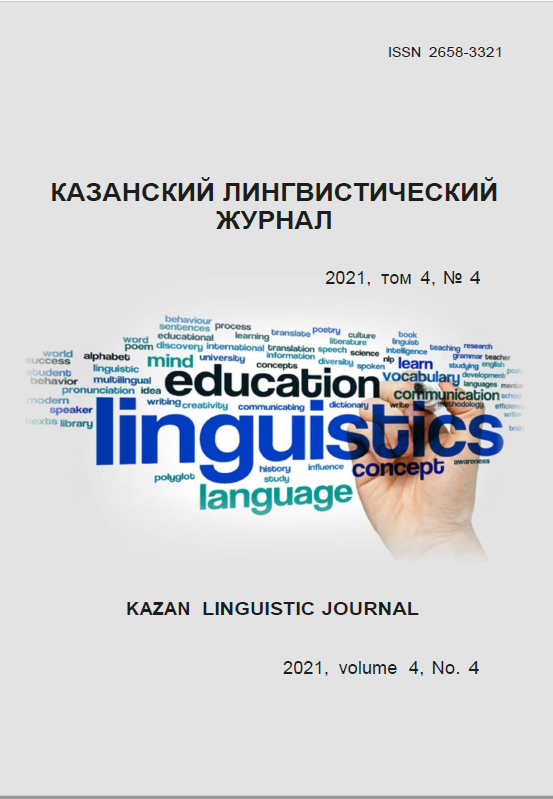Psycholinguistic reception of translated audiovisual materials
https://doi.org/10.26907/2658-3321.2021.4.4.524-536
Keywords:
psycholinguistic experiment, audiovisual translation, perception, reception, multimodal text, associative experimentAbstract
Audiovisual materials have been continuously growing in popularity since the mid-1950s. It was not until the 1990s that the translation of such materials in Russian Federation was actively developed. By its nature, this type of translation (audiovisual translation or AVT) is simultaneously aimed at the auditory and visual channels of perception of the addressee. However, the problems of understanding and perception of audiovisual materials and the question of whether or not there is a correlation between the psychological characteristics of individual recipients and the way they perceive the translation of these types of materials remains understudied, thus becoming the subject of our research. An overview of the literature on how audience perceptual features affect recipients' understanding of audiovisual fragments has been undertaken in this study. In particular, the study focuses on the levels of audiovisual reception of the recipients, as well as the factors that influence the perception of a specific type of multimodal text such as movies and TV series. Consequently, the main consistencies between two factors were identified: what specific perceptual features the audience has and exactly how they perceive and interpret audiovisual materials translated from the original language into the native language of the recipients. The article also presents some data from psycholinguistic experimental studies on comprehension problems and levels of perception of multimodal texts.
References
References
Cintas J.D., Szarkowska A. Introduction: Experimental research in audiovisual translation – Cognition, reception, production. The Journal of Specialised Translation. 2020; 33: 3–16.
Kruger J.-L., Soto-Sanfiel., M.T., Doherty, S., Ibrahim, R. Towards a cognitive audiovisual translatology: Subtitles and embodied cognition. John Benjamins Publishing Company. 2016; 171–194.
Orero Pilar, et al. Conducting experimental research in audiovisual translation (AVT): A position paper. The Journal of Specialised Translation. 2018; 30: 105–126.
Romero-Fresco P. The reception of subtitles for the deaf and hard of hearing in Europe: UK, Spain, Italy, Poland, Denmark, France and Germany. Bern: Peter Lang; 2015
Jensema C. Viewer reaction to different captioned television speeds. Institute for Disabilities Research and Training; 1997. Available from: https://www.dcmp.org/caai/nadh30.pdf [accessed: 08.04. 2021].
Szarkowska A., Gerber-Moro´n O. Viewers can keep up with fast subtitles: Evidence from eye movements. PLoS ONE. 2018; 13(6): e0199331. Available from: https://doi.org/10.1371/journal.pone.0199331 [accessed: 08.04. 2021].
Di Giovanni E. (Reception studies and audiovisual translation: Eye tracking research at the service of training in subtitling. Iconesoft Edizioni; 2019.
Callum W. A cognitive perspective on equivalent effect: using eye tracking to measure equivalence in source text and target text cognitive effects on readers. Perspectives. 2019; 27(1): 124–143.
Ragni V. More than meets the eye: an eye-tracking study of the effects of translation on the processing and memorisation of reversed subtitles. The Journal of Specialised Translation. 2020; 33: 99–128.
Green M., Brock T., Kaufman G. Understanding media enjoyment: the role of transportation into narrative worlds. Communication theory. 2004; 14(4): 311–327.
De Los Reyes Lozano J. Straight from the horse’s mouth: children’s reception of dubbed animated films in Spain. Jostrans. The Journal of Specialised Translation. 2020; 33: 233–258.
Kruger J.-L. Psycholinguistics and audiovisual translation. International Journal of Translation Studies. 2016; 28.2: 276–287.
García A. Psycholinguistic explorations of lexical translation equivalents: Thirty years of research and their implications for cognitive translatology. Translation Spaces. 2015; (4): 9–28.
Orrego-Carmona D., Łukasz D., Szarkowska A. Using translation process research to explore the creation of subtitles: an eye-tracking study comparing professional and trainee subtitlers. The Journal of Specialised Translation. 2018; (30): 150–180.
Panasiuk I. The free associative experiment as a psycholinguistic investigation method of the trans lation process: A theoretical insight. Germanica Wratislaviensia. 2020; (145): 179–198.
Pérez-González L. Audiovisual translation: Theories, methods and issues. London: Routledge; 356.
Szarkowska A., et al. The effects of text editing and subtitle presentation rate on the comprehension and reading patterns of interlingual and intralingual subtitles among deaf, hard of hearing and hearing viewers. Across Languages and Cultures. 2016; 17.2: 183–204.
Kruger J.-L. Eye tracking in audiovisual translation research from: The Routledge Handbook of Audiovisual Translation. Routledge; 2018. Available from: https://www.routledgehandbooks.com/doi/10.4324/9781315717166-22 [accessed: 08.04. 2021].






